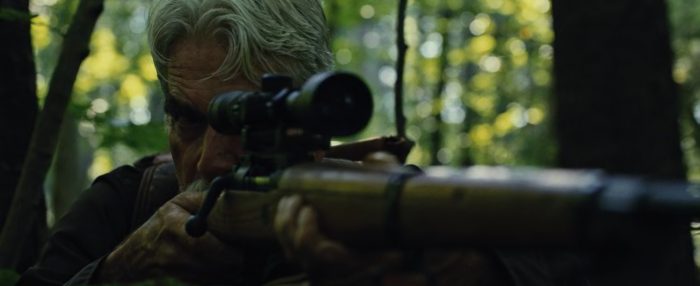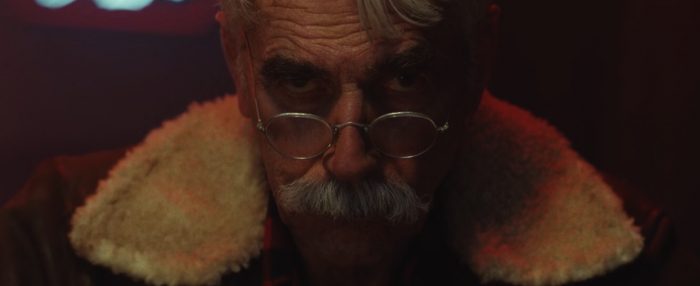
Even if the feature film debut from writer/director Robert D. Krzykowski was the single worst film of the year, it would still win the award for the greatest and most honest title of any movie ever: The Man Who Killed Hitler and Then The Bigfoot. While this may seem like the title of a winking, silly send up of adventure movies, it is in fact a quite ambitious and straight-ahead action work that also finds ways to weave in more contemplative ideas on aging, missed opportunities, and painfully broken dreams.
Set not so much in an alternative reality, but more in a less polished version of history, the film tells the life story of American war veteran Calvin Barr (played in the “present” by a particularly surly Sam Elliott). He’s living out what he assumes will be his final years in an isolated New England town, drinking a bit too much in the local pub and allowing his memories of younger days to occupy his mind to the point where he almost goes catatonic at his barstool. The few people in his life that might notice his drifting in and out begin to worry, and we would too, except that the things he’s remembering are the stuff of legend.
As the film’s title suggests, during World War II, Calvin (played as a younger man by Aidan Turner of The Hobbit trilogy) pulled off the ultimate mission as the war was winding down and the Third Reich was in chaos. He managed to impersonate a Nazi officer, evade tight security that checked him for weapons, and get into a room with Adolf Hitler, whom he then assassinated. The sequence is so perfectly and economically rendered that we almost think there’s a catch, and for a time, we even wonder if the older Calvin is fantasizing the events rather than remembering them. But as we eventually discover, at least in this secret history of the world, Calvin Barr shot Hitler in the chest, and both the Germans and the Americans decided that a fiction about a suicide in a bunker was the version of events the outside world should be spoon fed.
By having a title as specific as The Man Who Killed Hitler and Then The Bigfoot, it’s entirely sensible that the movie is actually not only about Calvin’s adventures. The film also focuses on his personal life, which was entwined and often hindered by his chosen profession. The love of his life, Maxine (Caitlin FitzGerald, from Masters of Sex), is left waiting behind for him, never knowing what he’s doing or how dangerous his missions are or even if he’ll return from them. As the older Calvin, Elliott so beautifully and achingly captures the melancholy of a man who willingly gave up the love of his life and has embraced the bitterness of the decision, blaming no one but himself. The one tie he is able to rekindle later in life is with his brother Ed (a surprisingly nuanced performance from comedian Larry Miller), and the scenes between them are the secret second heart of this movie.

Still struggling with how his heroic legacy ruined a great deal of the rest of his life, later-day (circa 1987, to be precise) Calvin is approached by a CIA agent (Ron Livingston) and a member of the Royal Canadian Mounted Police (Rizwan Manji) to assist them in hunting down and killing a creature living in the Canadian wilderness and carrying a deadly virus that kills everything it infects. It just so happens that the creature in question is Bigfoot, and no one in the film bats an eye at the suggestions that this supposedly mythological creature is real and only now must be slaughtered. Admittedly, keeping the movie’s title in mind, all anyone really wants to see is Sam Elliott scrap with Bigfoot, and boy, do we get that, in all of its brutal, bloody, and sometimes grotesque glory. But even in what one might believe is a cut-and-dry killing for the sake of the national security of two countries, there is regret and mournful hesitation as Calvin contemplates making this unique beast extinct. Whether we realized it or not, we’ve been waiting for Elliott to play this type of emo action hero for decades, and he gets a couple of chances to lay out some baddies in this film, including a three-against-one fight with some would-be carjackers early in the film.
In so many ways, filmmaker Krzyowski has done the impossible: constructed a glorious action-adventure piece that takes out the boring parts of all action movies (the exposition) and replaced it with a character study about a broken ex-soldier, looking back on his life with a deep sense of loss and disappointment – not at his actions as a soldier, but at the things he had to give up to be one. One of the biggest shocks about The Man Who Killed Hitler and Then The Bigfoot are some of the names that appear in its credits, including producers Lucky McKee (May, The Woman); Oscar-winning special effects guru Douglas Trumbull (who also provided some of the seamless effects for this movie); and the godfather of independent cinema John Sayles, whose gift of adding depth to B-movie storytelling is evident throughout this movie (taking nothing away from Krzyowski’s wonderfully nuanced screenplay).
From its world-weary hero to its no-nonsense, casual swapping of fiction for fact, The Man Who Killed Hitler and Then The Bigfoot uses action and something like science fiction to deliver an wholly entertaining, yet poignant message about aging, memories, and the seemingly endless possibilities of placing Sam Elliott at the helm of a genuinely solid action movie. Now excuse me, while I spend the next several months praying that this gets decent distribution and that audiences get to enjoy the beautiful landscapes of both the hinterlands and the distinguished lines in Elliott’s face on the big screen.
/Film Rating: 8 out of 10
The post ‘The Man Who Killed Hitler and Then The Bigfoot’ Has Far More to Offer Than An Amazing Title [Fantasia Film Festival] appeared first on /Film.
from /Film https://ift.tt/2mx5La1
